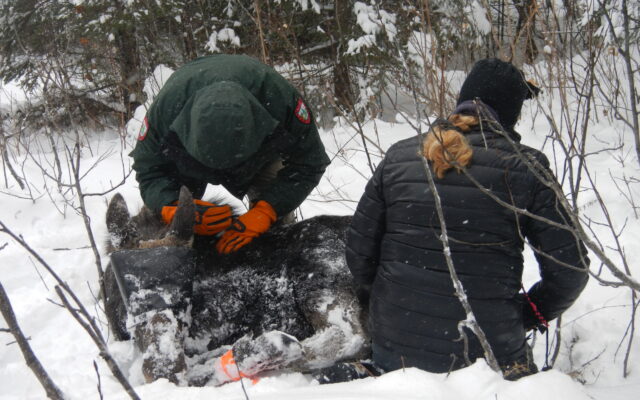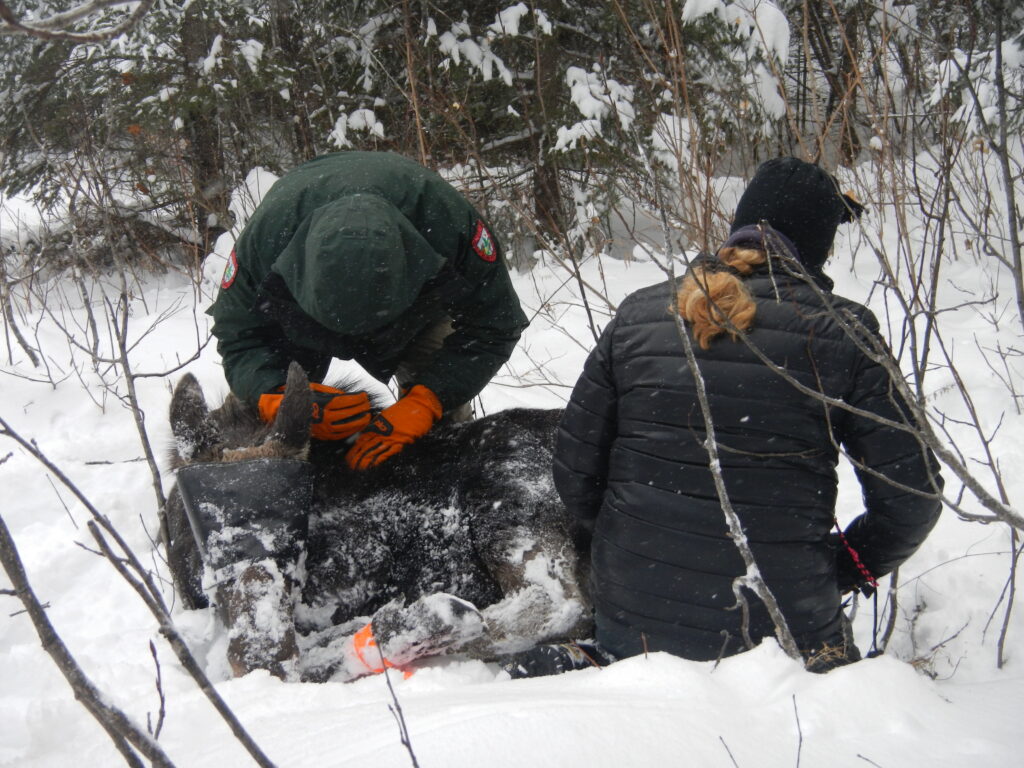
Helicopters and rocket nets are vital tools for monitoring Maine’s moose
By Pete Warner, Bangor Daily News Staff
To help protect moose, state officials sometimes must take extreme measures.
Among them is the annual capture and collaring of calves.
During the first week of January, a helicopter crew from Native Range, a Nevada-based company specializing in capturing wildlife, visited Wildlife Management District 4 in the North Maine Woods, where it captured and placed GPS tracking collars on 70 young moose.
Winter tick infestations are killing moose, and the Maine Department of Inland Fisheries and Wildlife uses the collars to monitor moose mortality. In 2020, 38 percent of the collared calves did not survive. That number reached 59 percent last year.

TICK CHECK – A biologist from the Maine Department of Inland Fisheries and Wildlife, left, performs a tick count before the moose is fitted with a GPS collar.
It is the ninth year of the aerial capture, the seventh utilizing the services of Native Range.
“It’s a big deal. I think it’s pretty exciting,” moose biologist Lee Kantar said of the process. “I think people would want to know that we are continuing to do some pretty intensive management.”
Critical to the operation is placing collars on moose calves. That’s where the expertise of pilot David Rivers and Native Range come in.
The three-person crew flies in the Robinson R44 helicopter to numerous locations within WMD 4. When they spot a young moose, they approach and, while airborne, launch a net that traps the animal.
“They use a .308 [caliber]-charged gun that is designed to hold a very large net with four lead weights in the corners, so it looks like a cone attached to a rifle,” Kantar said.
The pilot lands the chopper and technicians carefully approach the moose, immobilizing its legs and blindfolding it to help keep it calm. They draw blood (which is later studied at the University of Maine), count the winter tick larvae, affix the GPS collar and weigh the animal with the helicopter before releasing it.
The whole process lasts less than 10 minutes.
“It’s pretty impressive,” Kantar said.
DIF&W provides logistical support, including transporting 55-gallon drums to areas where the chopper can be refueled.
Because biologists are not involved in the captures, Kantar said the level of confidence they have developed through their relationship with Native Range is critical.
“There’s not a lot of vendors who do this work, obviously,” he said. “They’re very competent; highly regarded. They do an exceptional job.”
This year’s group of collared calves will be monitored from afar. When a collar stops moving, biologists head into the woods to confirm the moose has died.
“I would expect this year to be equal to, if not above, last year’s threshold,” Kantar said of this year’s expected moose mortality rate. “That’s based on winter tick counts from harvested moose this fall, but also looking at the winter tick loads on those moose captured [recently].”
The moose deaths usually begin in March, when the adult winter tick emerges from the nymph stage and begins feeding on the animals. The problem ramps up toward the end of the month and then intensifies throughout April.
For the third consecutive year, moose collaring in Maine is taking place in a special study area. WMD 4A encompasses the western half of the district.
There, DIF&W is conducting an experiment to gauge whether substantially reducing the moose population can help lower the number of winter ticks.
Last fall, the state held its first adaptive unit hunt in WMD 4A. Approximately 50 percent of the 510 permit holders for the extra hunt tagged a moose, limited to either cows or calves.
Kantar said the 70 moose collared came from a range throughout the study area. They also collared animals from the eastern half of the district, where regular hunting rules are in effect.
“You hope that the distribution covers the area geographically, but you don’t want to capture a moose right on the edge of the unit, on the Golden Road or [American] Realty Road or on the Quebec border,” Kantar said.
Rivers keeps detailed GPS positions for where the moose were collared, which gives biologists a clearer picture of their study group.
The data from moose in WMD 4 will be compared with research previously performed in WMD 8 (seven years) and WMD 2 (five years).
“That’s pretty significant to monitor animals at that level,” Kantar said.
In the meantime, DIF&W will continue to compile and evaluate the information from samples and measurements taken of moose during the three-week adaptive hunt in October and November.
What they learn may help shape any potential alterations made to the adaptive hunt.